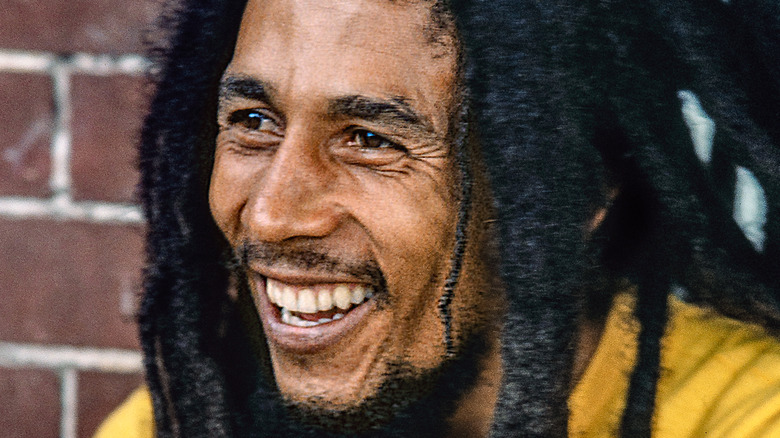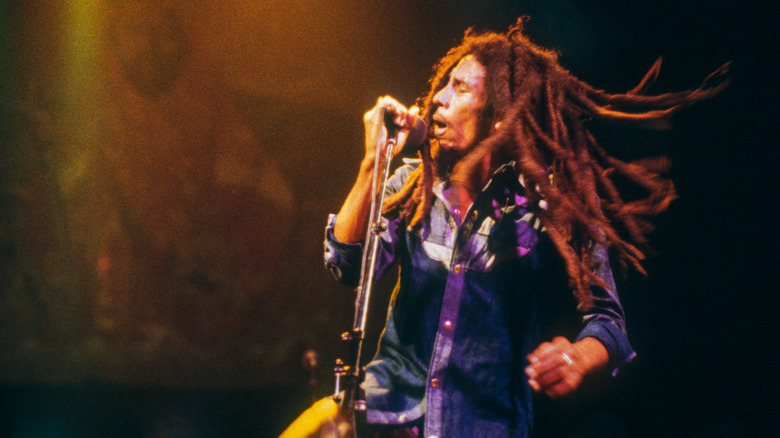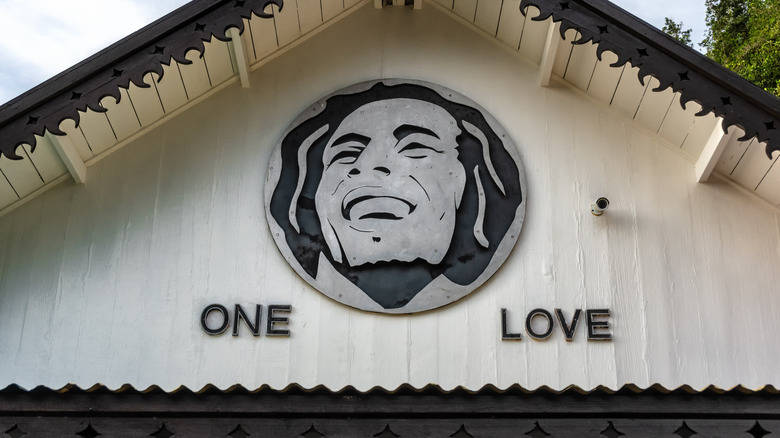The Surprising Items Bob Marley Is Buried With
On May 11, 1981, the music industry mourned the loss of one of its greatest artists, Bob Marley. The Jamaican singer and songwriter contributed to the worldwide popularization of reggae music starting in the '70s, gaining international fame together with his band, the Wailers. Marley's approach to songwriting incorporated themes of love, freedom, resistance from oppression, and dedication to his Rastafarian beliefs set to soulful melodies and irresistible beats. His music has stood the test of time, even if his life was cut short.
In the decades following his death, Marley has taken on something of a mythical status. Though he was simply a man, his contributions to music and the ideals he dedicated his life to left a mark that continues to proliferate throughout societies around the globe. Then-Prime Minister Edward Seaga was among those who spoke at his funeral. He said, "Bob Marley was never seen. He was an experience that left an indelible imprint with each encounter. Such a man cannot be erased from the mind. He is part of the collective consciousness of the nation" (via Smooth Radio).
Marley's funeral in Jamaica was an event for the entire island nation, with people coming to pay their respects in droves. According to The Guardian, there was an open casket viewing the day before his burial, and it's said that 100,000 people paid their final respects to the "Get Up Stand Up" singer. There they saw Marley's body in his bronze casket along with a few items he requested to be buried with.
The death of Bob Marley
In 1977, Marley injured his toe during a soccer match while he was touring in Europe, the same toe for which he'd previously sought treatment for injuries. It was then that he was diagnosed with a rare form of melanoma, called Acral melanoma, which is sometimes associated with injuries but also with genetics, per the AIM at Melanoma Foundation. His doctors suggested amputation to prevent the cancer cells from spreading, but Marley refused because of his religious beliefs.
Rastafarianism has mixed beliefs and follows some teachings in the Bible, but they are also rooted in African traditions and centered on spirituality. Rastafarians are opposed to a few medical procedures including amputations, blood transfusions, dialysis, and organ transplants. While it's not certain that an amputation would have prevented the cancer from spreading, at the time it was his best shot. They settled on just cutting away some of the cancerous tissue.
By 1980, Bob Marley's cancer had metastasized to his lungs, liver, and brain. He went to Germany to undergo unorthodox treatments, which helped him prolong his life for a few months. According to Biography, when he got worse, he wanted to return to his home in Jamaica, but he didn't make it. Instead, he died in Miami, Florida, at the age of 36. Marley's body was flown from Miami to Jamaica, and a state funeral was held on May 21, 1981, at Nine Mile, the village where Bob Marley was born, per The Guardian.
The items buried with Bob Marley
According to the book, "Catch a Fire: The Life of Bob Marley" the late icon was displayed in his casket with items that were important to him. Wearing a wig made of his dreadlocks that had fallen out from cancer treatment, Marley's body was positioned with one hand on his Gibson Les Paul guitar, which he often used while performing, and the other on a Bible opened to the page for Psalm 23, also known as "A Psalm of David."
Bob Marley was also wearing a ring that is said to have belonged to Haile Selassie, the Ethiopian Emporer whom Rastafarians believed to be God incarnate, and was buried with it still on. Per Vanity Fair, the ring was gifted to Marley from Ethiopia's Prince Asfa Wossen and has a black stone with the Lion of Judah. Marley is said to have never taken it off, and it can be seen on the album cover of "Legend: The Best of Bob Marley."
The last item buried with Marley was added by his wife, Rita Marley. At the end of the funeral ceremony, Rita approached her husband's casket and put a "stalk of ganja" inside, per The Guardian. Marley was a user of ganja — or marijuana — but he did not smoke it recreationally. It was his belief in Rastafarianism that propelled him to do so, as Rastafarians consider ganja a religious sacrament that helps calm the mind and bring users closer to God.


